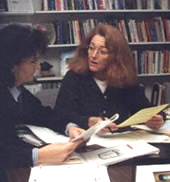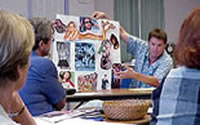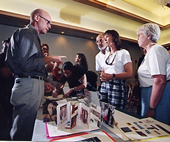Getting Started: Ideas for Introducing Media Literacy in your School or District
|
|
Compiled from questions to CML and what we've learned over many years!
1. Start with your best, most enthused teachers.
- A single teacher working alone can often feel isolated and become frustrated; working as a team or group provides support and builds motivation.
- Middle school is good place to start as collaborative learning and interdisciplinary units are already quite common at middle school level. But any collaborative teaching team in a department or a grade can experiment with introducing media literacy concepts across the curriculum.
- Expand the core group with a media librarian and/or curriculum specialist whose job it is to assist teachers in finding resources to accomplish planned learning objectives.
- Get help (if needed) from technical experts - computer technology specialists, video production, journalism or photography teachers. Production or constructing messages is essential in media literacy; students deserve access to top quality technology resources if they are going to master the skills of communicating in the 21st century.
- Don't forget to involve administrators. Without active support from the principal or superintendent, as well as other "stakeholders" including parents and community leaders, media literacy may become just another educational "fad."
- Build toward having several teachers, library media specialists or staff development leaders gain the experience and expertise in the field needed to become in-house or in-district "consultants" or "coaches." Self-reflection by teams of teachers over time with a knowledgeable coach / consultant is the most effective way to stimulate the integration of media literacy throughout your school or district.
2. Explore your state or local standards to see how teaching media literacy skills can support what you're already mandated to teach.
-
Media literacy is not a new subject to teach but a new way to teach all subjects!
-
Media literacy is a logical extension of traditional language arts: reading/writing and listening/speaking; today we must add viewing (reading) and creating/producing (writing) using all media forms
-
"Creating/producing" opens up a multitude of connections to self-expression and practice in sequencing, summarizing, interpreting, etc. Although video or film may seem to be the ultimate production project, consider a range of activities from still photography to PowerPoint presentations, from a notebook journal to a wall mural.
-
Health standards contain many important linkages to media literacy, including classroom units on tobacco prevention, nutrition education, sexuality and sexual behavior, alcohol and drug abuse as well as beauty and body image
-
Social studies is a field ripe with media literacy connections. It also connects to areas such as LifeSkills, English as a Second Language (ESL) or Character Education. In parochial schools, media literacy may be incorporated in religion or philosophy classes.
3. Acknowledge our "love/hate" relationship with media and popular culture.
-
Encourage an attitude of inquiry and exploration of media and popular culture rather than disparagement or dismissal. Remember, everyone tries to "make meaning" out of their media experiences. Acknowledge that many points of view and interpretations are possible and no single view is always "right" or "wrong."
-
Stimulate open conversation about new TV series, popular movies, trends in advertising, whatever students are watching and talking about. Become familiar with youth culture and you'll find many points of connection to what you're already teaching.
-
Check into your students' world by asking:
-- "So it's the weekend. Got any suggestions for a video I should rent?"
-- "If I have time for a little TV tonight, is there anything good on?"
-- "I'd like to go to a movie on Saturday - what's playing at the mall?"
-- Do a 5-minute brainstorm: What's going on in your world right now that's cool/uncool, fascinating, unfair, outrageous or worrisome? Once you've got a list, keep your eyes and ears peeled for examples from their world that you can use to illustrate concepts in the classroom. -
Create a media literacy bulletin board in the teacher's lounge and invite faculty to post short reviews of books, reflections on a new movie, analysis of an ad campaign, insightful work done by students.
4. Create a reference resource center (or at least a shelf in the library) with background materials as well as teaching resources.
- Help build success for teachers by providing a budget for teaching resources. And build in time for teachers to dig into and review teaching materials that look promising. The goal is to integrate media literacy activities into curricular goals in language arts, social studies, health and other mandated subjects. Integration takes time
- Be sure to include copies of Part II of the MediaLit Kit™ : Five Key Questions That Can Change the World that contains 25 model classroom activities for K-12 media literacy.
- Study CML's online catalog of teaching materials for the quality resources most suited to your educational goals. There is no one perfect package or program for all grades and all subjects but quality off-the-shelf resources can be useful to jumpstart your curriculum.
- Be sure to include books of theory and research to deepen your grounding in media literacy pedagogy and best practices. Promote reflection on media literacy pedagogy by reading the literature, exploring top media literacy sites on the Internet, critiquing and coaching each other.
5. Network, network, network -- nationally / regionally / locally.
-
Don't reinvent the wheel; connect with others who may also be looking for connections!
-
Join NAMLE, National Association for Media Literacy Education, the new professional membership organization for teachers and practitioners of inquiry-based media literacy education. Help build a strong professional association that can serve the field with a national voice. Send two (or more) teachers to NAMLEs every-two-year National Media Education Conference held in various cities.
-
Subscribe to e-letters, list-servs and publications that cover or serve the media literacy field. You'll soon discover what issues are under discussion, how others are thinking about them and where you can find out more. But don't just lurk, join the conversation!
-
Media literacy panels, workshops and presentations are increasingly offered at state or national professional conferences for teachers of English or Social Studies, school librarians, curriculum and technology coordinators, even public health. Check the program offerings carefully - you may have the opportunity to participate in a lively, informative session.



